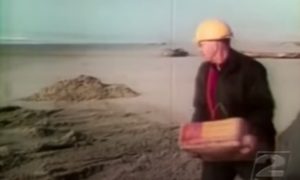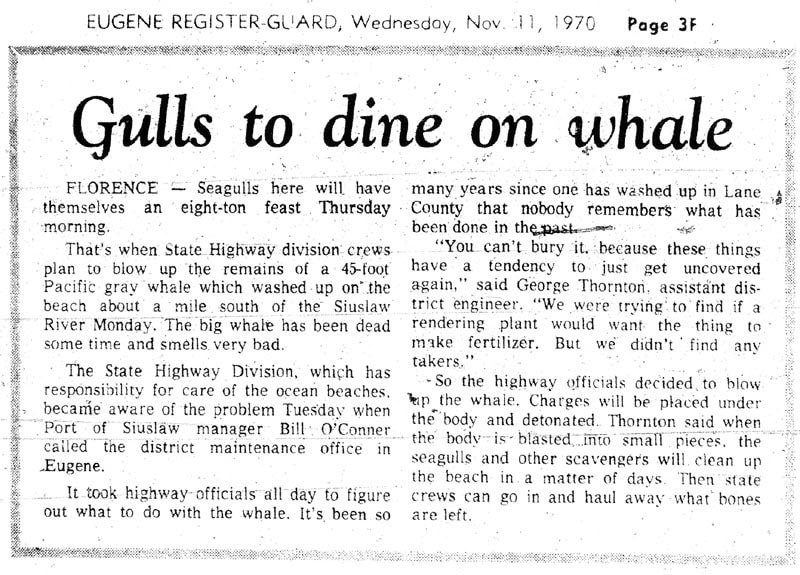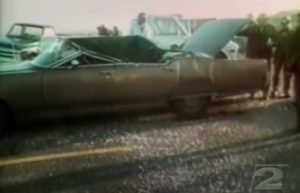The First-Ever Viral Video (which, naturally, was of the “weird news” variety!) was shot a half century ago today. This is its story, with a higher resolution video than most have ever seen.
The 45-foot-long, 8-ton sperm whale washed up on a beach near Florence, Ore., on November 9, 1970, and quickly became a local curiosity. But three days later, residents couldn’t stand the smell anymore and demanded the state do something about it. At the time, the Oregon Highway Division (now the Oregon Department of Transportation) had jurisdiction over the state’s beaches.
The Now-Classic Report

Reporter Paul Linnman of Portland’s KATU covered what happened next, accompanied by news cameraman Doug Brazil. That video is below. Linnman had been on the job for about three years, and was already an expert at off-the-cuff reporting on camera — back in those days, on 16mm film. Thankfully, in color.
Highway engineer George Thornton brought in twenty cases of Hercules-brand dynamite. No, not twenty sticks of dynamite: twenty 50-pound cases were planted by the department’s “demolition experts.” They mostly worked to remove boulders that fell on the highway, not blubbery carcasses from the beach.

“The blast blasted blubber beyond all believable bounds,” the poetic reporter deadpanned. “The humor of the entire situation suddenly gave way to a run for survival” — even though the 75 or so spectators had been moved a quarter-mile away. “Pieces of meat passed high over our heads,” Linnman said. A brand new Oldsmobile Regency 98 was creamed by a chunk.


The …Uh… Fallout

“My insurance company’s never going to believe this,” said the car’s owner, Walter Umenhofer, who was 38 at the time. Instead of filing a claim with his own insurer, he filed with the state’s insurance company to cover his gold beauty. They paid him in full, and he used the money to buy another one.
In the 25 years that followed, Umenhofer went on TV multiple times to tell the story. “What made it funny was no one got hurt,” he said. On the other hand, “it’s a hell of a note that the only thing you’re really famous for in your entire life is your car was smashed by a flying whale.”
While no one was injured, Linnman reported, “everyone was covered by small particles of dead whale.” And so were the parked cars.
And even after all that, a major chunk of the whale was still left next to the crater in the sand dug out by the explosion. “It went just exactly right,” highway engineer Thornton said, “except the blast funneled a hole in the sand under the whale” so the whale parts went straight up and out, rather than out to sea as planned. Thornton brought in a bulldozer to bury the rest.
 One thing that amuses me: KATU didn’t post the video online until 2019, on the 49th anniversary of the classic tale. Yet even then, the video quality was poor, and the posting caption notes it is, “The infamous exploding whale story from KATU News, circa 1970.”
One thing that amuses me: KATU didn’t post the video online until 2019, on the 49th anniversary of the classic tale. Yet even then, the video quality was poor, and the posting caption notes it is, “The infamous exploding whale story from KATU News, circa 1970.”
Circa 1970?! They don’t know the exact date …when they’re posting it on the anniversary? The Five Ws of news, guys, is Who, What, When, Where, and Why!
The Making of a Legend
Thornton was deeply embarrassed by the failure to obliterate the whale, especially since he had consulted with the U.S. Navy first. He didn’t like it one bit that the video, and thus the story, went viral online. A few months after the incident, he was promoted to district engineer for the Medford area.
When Linnman asked Thornton for an interview years later, he refused, saying “whenever I talk to the media, it blows up in my face.” (Yes, really!) “I don’t think he was trying to be funny,” Linnman said. “It’s just the way he felt.” After 37 years on the job, Thornton retired from the Oregon DOT in 1984 — before the video went viral. He died on October 27, 2013, at 84.

But Wait: the Internet wasn’t a thing in 1970. How did it become perhaps the first viral video sensation in 1990? Indeed, the story was mostly forgotten by then, especially outside Oregon.
Enter Florida (of course!) newspaper columnist Dave Barry. On May 20, 1990, he wrote a column titled “The Farside Comes to Life in Oregon” after seeing a “pirated” video of the news report. The column, and the video, were posted on a BBS — a dial-up Bulletin Board System that predated wide public access of the Internet.
As is often the case of something crossing over to the Internet, “someone” altered Barry’s column before they first posted it onto the BBS. It was common for BBSs to be linked together (by landline telephone), so the embellished version spread quickly.
“We started getting calls from curious reporters across the country right after the electronic bulletin board story appeared” twenty years later, ODOT spokesman Ed Schoaps told Snopes. “They thought the whale had washed ashore recently, and were hot on the trail of a governmental blubber flub-up. They were disappointed that the story has 25 years of dust on it.”
So when This is True entered the scene in 1994, it was one of two most-suggested story for years, because even then new netizens figured it “just happened” when they saw the most famous TV news report online. The other such story? Lawn Chair Larry, the guy who flew a lawn chair up to 16,000 feet over Los Angeles. That happened in 1982.

In April 2000 I got a tour of the KATU studios from an employee — a True reader. As I left, she gave me a wonderful gift: a VHS dub of Linnman’s report. I wish I knew where it was now! Probably in a box somewhere. She said it was a popular request from visitors.
Linnman retired in 2004 after more than 30 years at KATU (not counting five years off for some other gigs in the middle). He hosted a radio show on Portland’s KEX-AM from 2003 to 2014. As of this writing, he is 73 years old …and will always be remembered as “the guy” who brought the exploding whale to the world.
Lesson Learned?
In 1979, when 41(!) sperm whales beached themselves south of Florence, “the possibility of blasting the carcasses to bits with dynamite was quickly passed over,” the state said. Their policy after the 1970 debacle: bury the things. Lesson learned.
– – –
Bad link? Broken image? Other problem on this page? Use the Help button lower right, and thanks.
This page is an example of my style of “Thought-Provoking Entertainment”. This is True is an email newsletter that uses “weird news” as a vehicle to explore the human condition in an entertaining way. If that sounds good, click here to open a subscribe form.
To really support This is True, you’re invited to sign up for a subscription to the much-expanded “Premium” edition:
Q: Why would I want to pay more than the minimum rate?
A: To support the publication to help it thrive and stay online: this kind of support means less future need for price increases (and smaller increases when they do happen), which enables more people to upgrade. This option was requested by existing Premium subscribers.

There was an Australian movie in 2017 called Swinging Safari which has the exploding whale as the climax of the quite funny film. I never realised it was based on a true story.
One of my favourite “It seemed like a good idea at the time” stories….
I was in ninth grade in Seattle when this happened, so I should remember it well. But I don’t! (Well, I *was* a teenager at the time, so have a good excuse.)
Thanks for the “reminder”. It’s a great story, and as a reasonably educated adult, I can only say: Dynamite? Really?!
I remember it well. Blowing up whales isn’t like building roads.
It’s good to hear I wasn’t the only one that thought this story was new when Dave Barry wrote about it.
Love it, Randy! Thanks for resurrecting this great story.
Remembering what “not to do” is important!
So, fifty years later, on that stretch of sand, the majority remains of that blown-up whale lies buried? Just curious.
—
I’d think that scavengers got most of it, and the rest is long rotted away save for some bones here and there. -rc